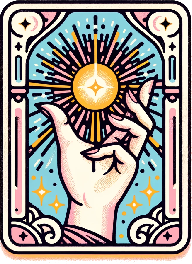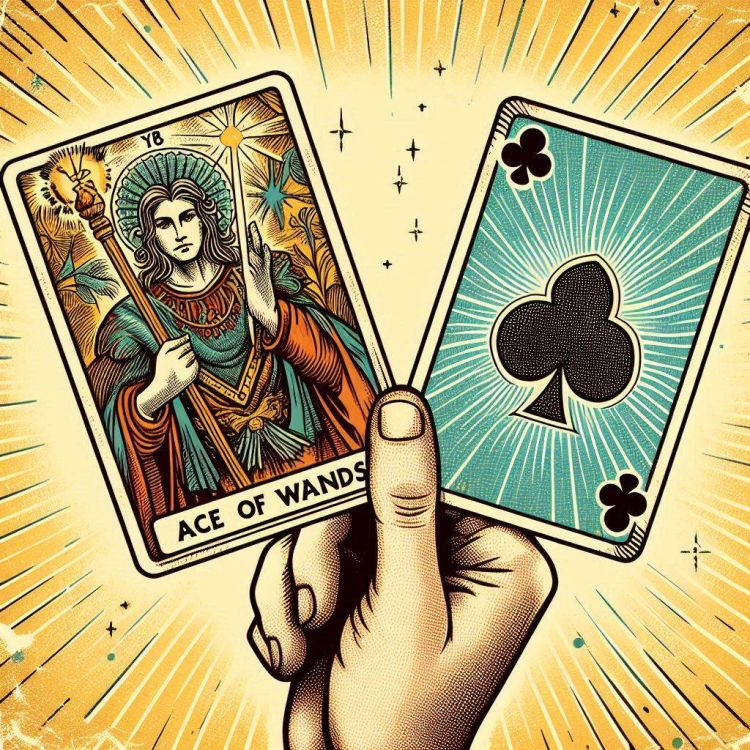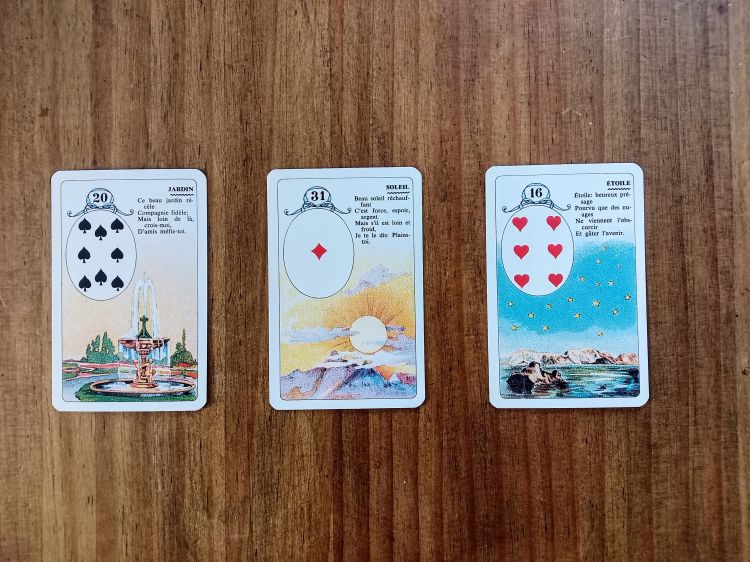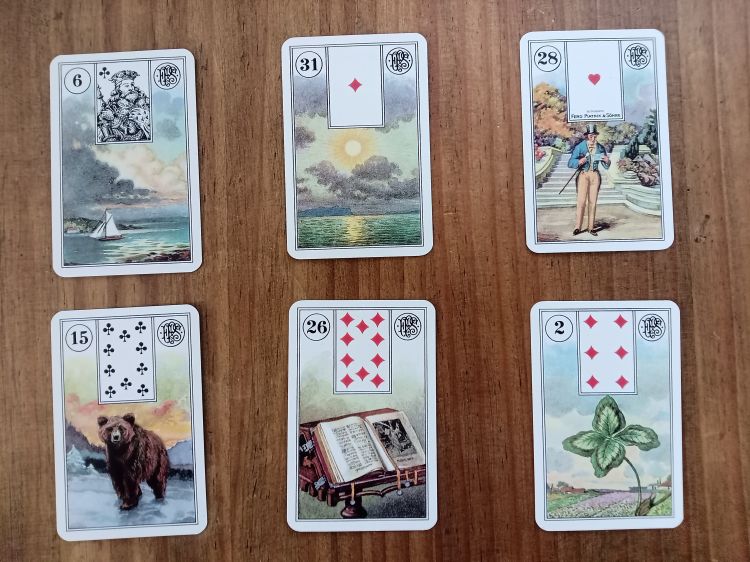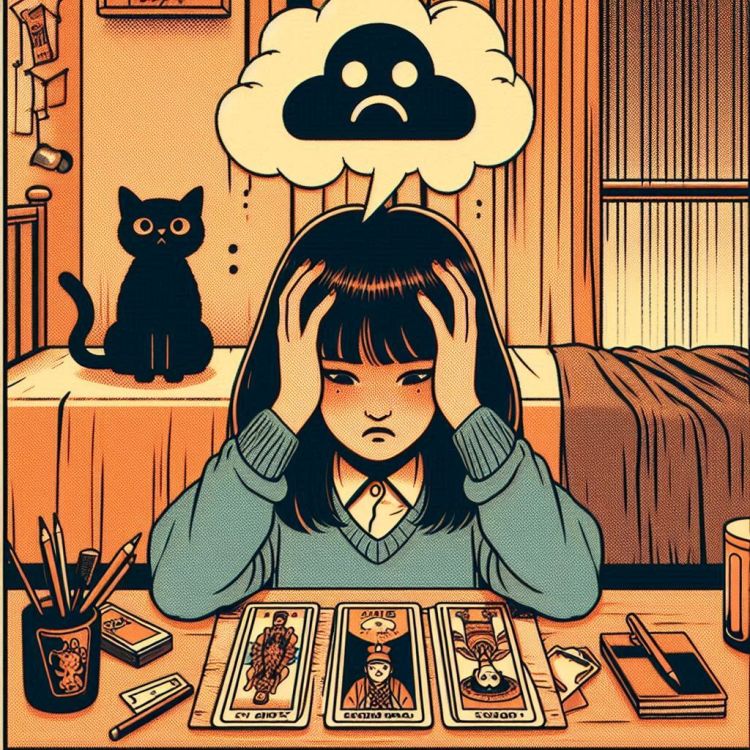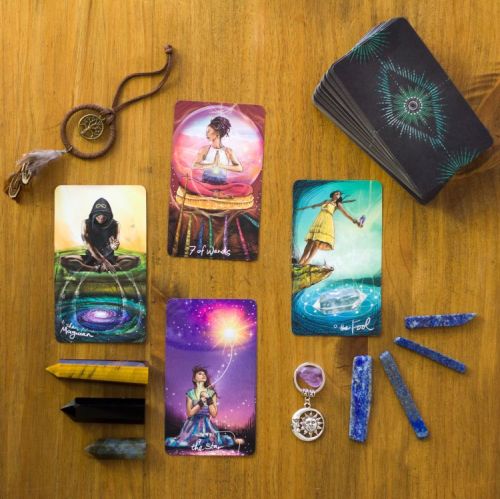Here is an interpretation grid for using values through a square combination (4 cards) in a Petit Lenormand reading, using the symbolism of the number Four and the card values (6, 7, 8, 9, 10, Jack, Queen, King, Ace). The number Four represents stability, construction, determination, and laying solid foundations to achieve a goal.
Combination with the value 6
Stability in Organization and Foundations: Cards with the value 6 (Tower, Star, Cross, Clover) bring elements of structure, luck, and divine guidance. A square formed with these cards indicates that evolution rests on solid foundations but may involve spiritual or organizational challenges.
Example: Tower + Clover + Star + Cross → Progress requires proper structuring (Tower), while being open to lucky opportunities (Clover) and following a clear vision (Star), despite necessary trials or sacrifices (Cross).
Combination with the value 7
Balanced Communication and Interactions: Cards with the value 7 (Letter, Tree, Mice, Birds) represent communication, personal growth, and social interactions. A square here could reflect solid foundations based on the importance of communication, where stability is achieved through exchange and adaptability.
Example: Letter + Tree + Mice + Birds → Building a stable situation (4) requires clear exchanges (Letter), personal growth (Tree), avoiding losses or distractions (Mice), with attention to adaptability and lightness in exchanges (Birds).
Combination with the value 8
Resolution through Challenges and Clarity: Cards with the value 8 (Garden, Mountain, Moon, Key) symbolize both external challenges and enlightening solutions. A square with these cards emphasizes stable progress built on the ability to resolve concrete obstacles or achieve a deep understanding of hidden elements.
Example: Mountain + Key + Garden + Moon → Stability is achieved by facing major obstacles (Mountain) and finding a solution or key (Key) that illuminates the situation (Moon) while being open to external or social opportunities (Garden).
Combination with the value 9
Transformation through Movement and Change: Cards with the value 9 (Anchor, Rider, Fox, Coffin) are associated with movements, adaptations, and deep transformations. A square here reflects a stable but constantly evolving construction, where adaptability is essential to maintain balance.
Example: Rider + Fox + Anchor + Coffin → Stability (4) relies on quick actions (Rider), cunning or caution (Fox), while finding a solid anchor (Anchor) in the face of a major transformation or necessary end (Coffin).
Combination with the value 10
Ambition Leading to Achievement: Cards with the value 10 (Ship, Dog, Bear, Book) symbolize expansion, loyalty, and knowledge. A square formed with these cards illustrates the creation of solid foundations to succeed and achieve ambitious goals through loyalty and knowledge.
Example: Ship + Bear + Book + Dog → A stable foundation (4) is built by expanding new horizons (Ship), power and authority (Bear), deep knowledge (Book), and the loyalty of close ones (Dog).
Combination with the value Jack
Conflicts Leading to New Construction through (Re-)Birth: Cards with the value Jack (Child, Heart, Whip, Scythe) symbolize beginnings, but also necessary conflicts or cuts. A square formed here highlights a nascent situation, where challenges and tensions must be faced to build a stable foundation.
Example: Child + Heart + Scythe + Whip → A new beginning (Child) or relationship (Heart) requires cutting away what no longer serves (Scythe), facing conflicts directly (Whip) to build new stability.
Combination with the value Queen
Anchored and Firm Choices Leading to Transformation and Change: Cards with the value Queen (Bouquet, Stork, Snake, Paths) are oriented towards changes, choices, and subtle opportunities. A square with these cards reflects progress based on delicate transformations and important choices to establish stability.
Example: Stork + Snake + Paths + Bouquet → An evolutionary change (Stork) involves complex choices (Snake) and important decisions (Paths), leading to gratifying or joyful stability (Bouquet).
Combination with the value King
Power and Organization Led with Stability and Authority: Cards with the value King (Lily, House, Clouds, Fish) represent authority, protection, and power. A square with these cards illustrates a stable foundation built on power and authority, even while going through periods of uncertainty.
Example: Lily + House + Fish + Clouds → Stability is built through a figure of authority or protection (Lily + House) and an abundance of resources (Fish), even if moments of confusion or temporary uncertainty (Clouds) may arise.
Combination with the value Ace
Will and Commitment Leading to Creation: Cards with the value Ace (Man, Lady, Ring, Sun) symbolize achievement, success, and commitment. A square formed with these cards indicates that stability rests on firm decisions, clear commitment, and strong will.
Example: Ring + Sun + Man + Lady → Stability (4) is created through a solid commitment (Ring) illuminated by great clarity (Sun), reinforced by key figures (Man and Lady) who bring leadership and support.
Conclusion
This interpretation grid for squares in the Petit Lenormand, using the symbolism of the number Four, highlights how stability, structure, and lasting construction rely on the different card values. Each square forms a solid foundation for the evolution or progression of a situation, depending on the energies and influences specific to each card combination.

